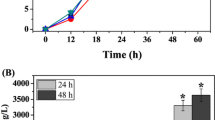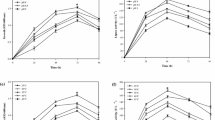Abstract
A new method for breeding the hydrocortisone overproducing strain Curvularia lunata by screening ketoconazole-resistance mutant was developed. A hydrocortisone overproducing mutant C. lunata KA-91 with ketoconazole-resistance marker was obtained from protoplasts treated with ultraviolet radiation. The hydrocortisone conversion rate of C. lunata KA-91 was increased by 42.1% compared to the original strain CL-114 at the substrate 17α-hydroxypregn-4-en-3, 20-dione-21-acetate addition concentration of 1.0 g/L. The by-products produced by KA-91 were fewer than those of the original strain. It was assumed that the higher cytochrome P450 content of ketoconazole-resistance mutant resulted in the increase of 11β-hydroxylation capacity. The culture conditions for biotransformation of 17α-hydroxypregn-4-en-3, 20-dione-21-acetate to hydrocortisone were optimized by response surface methodology. Plackett–Burman design was applied to elucidate the key factors affecting the hydrocortisone production, and the results indicated that glucose, initial pH, and glucose to total nitrogen sources ratio (ω) had significant effects on hydrocortisone production. Box–Behnken design was employed to search for the optimal parameters of those three key factors. According to the model, the trial checking at the optimal conditions showed a high hydrocortisone conversion rate of 82.67%.


Similar content being viewed by others
Abbreviations
- HCCR:
-
hydrocortisone conversion rate (%)
- RT:
-
retain time (min)
- Y :
-
experimental response of Plackett–Burman design (HCCR, %)
- Z :
-
experimental response of Box–Behnken design (HCCR, %)
- x i :
-
coded value of the variable X i
- X i :
-
variable
- X 0 :
-
value of X i at the center point
- X :
-
step change
- α i :
-
linear coefficient
- α 0 :
-
intercept of α i
- β i :
-
linear coefficients
- β ii :
-
squared coefficients
- β ij :
-
interaction coefficients
- β 0 :
-
intercept of β i
- ω :
-
glucose to total nitrogen sources ratio
References
Colingsworth, D. R., Karnemaat, J. N., Hanson, F. R., Brunner, M. P., Mann K. M., & Haines W. J. (1953). A partial microbiological synthesis of hydrocortisone. Journal of Biological Chemistry, 203, 807–813.
Naim, N., Adham, N. Z., Abd El-Rehim, R., & Abd El-Hady, A. (2003). Prednisolone production using Pseudomonas fluorescens cells immobilized with polymer carrier produced by radiation polymerisation. Process Biochemistry, 38, 1083–1089.
Wilmanska, D., Milczarek, K., Rumijowska, A., Bartnicka, K., & Sedlaczek, L. (1992). Elimination of by-products in 11β-hydroxylation of Substance S using Curvularia lunata clones regeneration from NTG-treated protoplasts. Applied Microbiology and Biotechnology, 37, 626–630.
Chen, K. C., & Wey, H. C. (1990). 11β-Hydroxylation of cortexolone by Curvularia lunata. Enzyme and Microbial Technology, 12, 305–308.
Sukhodolskaya, G. V., Angelova, B. A., & Koshcheenko, K. A. (1991). Synthesis of steroid 11β-hydroxylase and peculiarities of the transformation of crystalline Reichstein’s substance S by free and immobilized mycelium of Curvularia lunata VFM F-644. Prikladnaâ Biohimiâ Mikrobiologiâ, 27, 701–710.
Hesketh, A., & Ochi, K. (1997). A novel method for improving Streptomyces coelicolor A3(2) for production of actinorhodin by introduction of rpsL (encoding ribosomal protein S12 mutation conferring resistance to streptomycin. Journal of Antibiotics, 50, 532–535.
Hu, H., & Ochi, K. (2001). Novel approach for improving the productivity of antibiotic-producing strains by inducing combined resistant mutations. Applied and Environmental Microbiology, 67, 1885–1892.
Paraszkiewicz, K., & Długonski, J. (1998). Cortexolone 11β-hydroxylation in protoplasts of Curvularia lunata. Journal of Biotechnology, 65, 217–224.
Suzuki, K., Sanga, K. I., Chikaoka, Y., & Itagaki, E. (1993). Purification and properties of cytochrome P-450 (P-450lun) catalyzing steroid 11β-hydroxylation in Curvularia lunata. Biochimica et Biophysica Acta, 1203, 215–223.
Edlind, T. D., Henry, K. W., & Metera, K. (2001). Aspergillus fumigatus CYP51 sequence: potential basis for fluconazole resistance. Medical Mycology, 39, 299–302.
Lamb, D. C., Kelly, D. E., & White, T. C. (2000). The R467K amino acid substitution in Candida albicans sterol 14 alpha-demethylase causes drug resistance through reduced affinity. Antimicrobial Agents and Chemotherapy, 44, 63–67.
Sanglard, D., Ischer, F., & Koymans, L. (1998). Amino acid substitutions in the cytochrome P450 lanosterol 14α-demethylase from azole-resistant Candida albicans clinical isolates contribute to resistance to azole antifungal agents. Antimicrobial Agents and Chemotherapy, 42, 241–253.
Hamamoto, H., Hasegawa, K., & Nakaune, R. (2000). Tandem repeat of a transcriptional enhancer upstream of the sterol 14-demethylase gene (CYP51) in Penicillium digitatum. Applied and Environmental Microbiology, 66, 3421–3426.
Schnabel, G., & Jones, A. L. (2001). The 14 alpha-demethylase (CYP51A1) gene is overexpressed in Venturia inaequalis strains resistant to Myclobutanil. Phytopathology, 91, 102–110.
Wang, J., Chen, C. Z., Li, B. A., Zhang J. H., & Yu, Y. T. (1998). Production of hydrocortisone from cortexolone-21-acetate by immobilized Absidia orchidis in cosolvent-containing media. Enzyme and Microbial Technology, 22, 368–372.
Krishna, S. H., Manohar, B., Divakar, S., Prapulla, S. G., & Karanth, N. G. (2000). Optimization of isoamyl acetate production by using immobilized lipase from Mucor miehei by response surface methodology. Enzyme and Microbial Technology, 26, 131–136.
Chen, Q. H., He, G. Q., & Mokhtar, A. M. (2002). Optimization of medium composition for the production of elastase by Bacillus sp. EL31410 with response surface methodology. Enzyme and Microbial Technology, 30, 667–672.
Mahat, M. K., Illias, R. M., Rahman, R. A., Rashiol N. A. A., Mahmood N. A. N., & Hassan, O. (2004). Production of cyclodextrin glucanotransferase (CGTase) from alkalophilic Bacillus sp. TS1-1: media optimization using experimental design. Enzyme and Microbial Technology, 35, 467–473.
Li, C., Bai, J., & Cai, Z. L. (2002). Optimization of a cultural medium for bacteriocin production by Lactococcus lactis using response surface methodology. Journal of Biotechnology, 93, 27–34.
Wang, M., Guo, Y. W., Lu, W. Y., Bao, H. K., & Du, L. X. (2004). Breeding of high hydrocortisone transforming strains and their optimal fermentation conditions. Chinese Journal of Applied and Environmental Biology, 10, 663–666.
Lu, W. Y., Guo, Y. W., Gong, W., Wang, M., & Du, L. X. (2003). Protoplast formation and regeneration of Curvularia lunata. Pharmaceutical Biotechnology, 10, 141–143.
Omura, T., & Sato, R. (1964). The carbon monoxide-binding pigment of liver microsomes. Journal of Biological Chemistry, 239, 2370–2378.
Lu, W. Y., Guo, Y. W., Wang, M., & Du, L. (2003). Determination of hydrocortisone and related compounds in the culture of hydrocortisone by HPLC. Chinese Journal of Chromatography, 21, 388–390.
SAS Institute Inc. (1985). RSREG procedure. In: SAS:STAT user ’s guide, version 5. Cary, NC: SAS Institute Inc., pp 725–734.
Lu, W. Y., Guo, Y. W., Chen, P. C., Wang, M., & Du, L. X. (2003). Role of Curvularia lunata cytochrome P450 during the 11β-hydroxylation of steroid. Journal of China Pharmaceutical University, 34, 573–576.
Clark, T. A., Chang, R., & Maddox, I. S. (1982). The effect of dissolved oxygen tension on 11β- and 19-hydroxylation of Reichstein’s substance S by Pellicularia filamentosa. European Journal of Applied Microbiology and Biotechnology, 14, 131–135.
Box, G. E. P., & Behnken, D. W. (1960). Some new three level designs for the study of quantitative variables. Technometrics, 2, 455–476.
Acknowledgments
The authors wish to acknowledge the financial support provided by the Key Science and Technology Development Foundation of Tianjin (No. 023180211) and the Key Science and Technology Research Program of Chinese Educational Ministry (No. 01004).
Author information
Authors and Affiliations
Corresponding author
Rights and permissions
About this article
Cite this article
Lu, W., Du, L., Wang, M. et al. Optimisation of Hydrocortisone Production by Curvularia lunata . Appl Biochem Biotechnol 142, 17–28 (2007). https://doi.org/10.1007/s12010-007-0005-8
Received:
Accepted:
Published:
Issue Date:
DOI: https://doi.org/10.1007/s12010-007-0005-8




